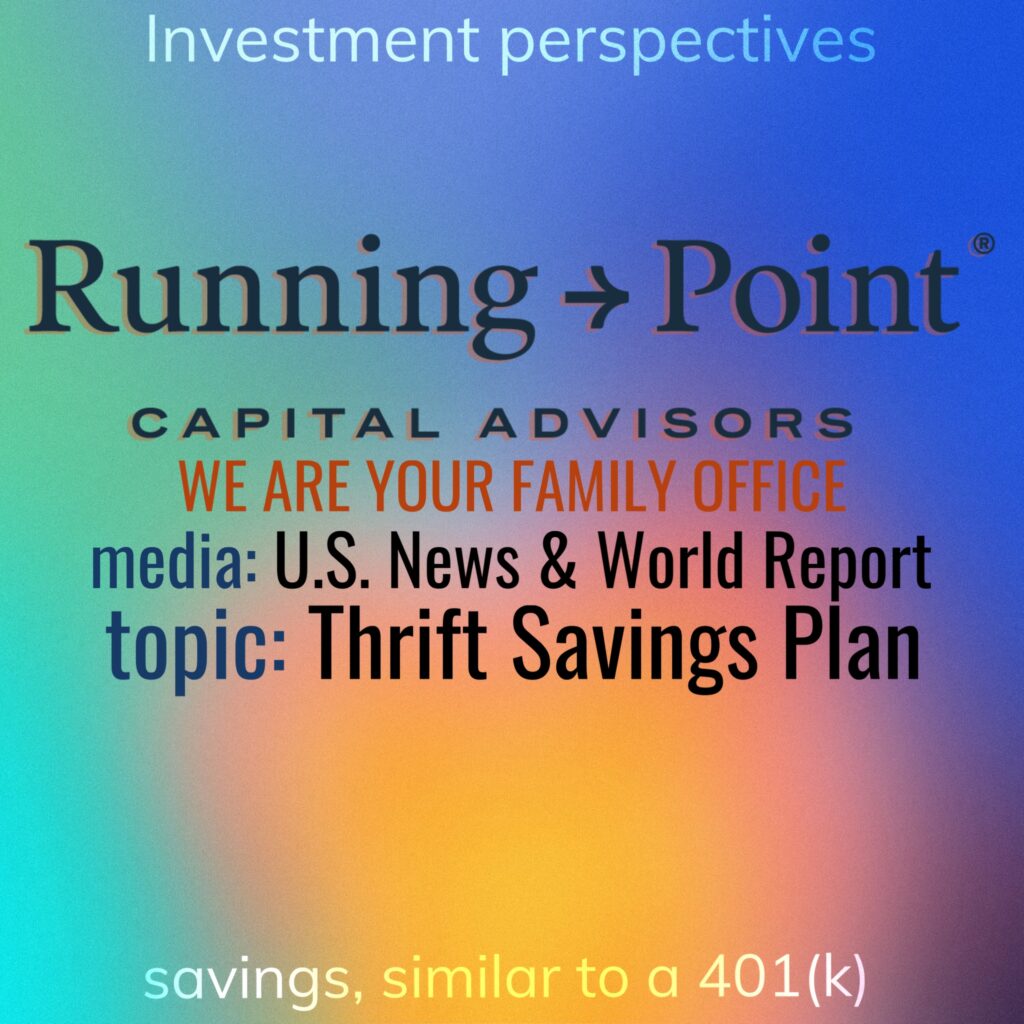What is a Thrift Savings Plan?
Running Point and its chief investment officer, Michael Ashley Schulman, CFA, were quoted by U.S. News & World Report in an article — by reporter Brian O’Connell, “What Is the Thrift Savings Plan?” — regarding Thrift Savings Plan (TSP) retirement savings and investment accounts for federal government employees and uniformed service members.
When and how did TSP start?
The Thrift Savings Plan (TSP) is a tax deferred retirement savings and investment plan for federal employees and uniformed services members. It was established by Congress and signed by President Reagan in 1986 as part of the Federal Employees’ Retirement System Act. The TSP is a defined contribution plan, similar to 401(k) plans offered by private companies.
TSP limits
The 2023 Thrift Savings Plan (TSP) contribution limit is $22,500. This limit applies to both traditional and Roth contributions made by an employee during the calendar year. If you are age 50 or older (or will be turning age 50 in 2023), you may also make TSP Catch-up contributions. The 2023 IRS annual limit for Catch-up contributions is $7,500. This amount is in addition to the regular TSP limit of $22,500. You cannot contribute more than $22,500 ($30,000 with catch-up contributions) across both accounts in any given calendar year.
All TSP contributions must come from payroll deduction or from rollovers from qualified plans.
TSP investment options
The TSP offers three types of investment options, Lifecycle Funds, Individual TSP funds, and mutual funds. Lifecycle Funds are similar to target date balanced funds that adjust their equity and bond weightings over time to become more conservative. Lifecycle fund options currently range from 2025 to 2065 as well as an income fund choice. Amongst the Individual TSP funds there are five focused yet diversified fund choices to choose from; a U.S. government securities fund, a U.S. fixed income (bond) fund, a U.S. large-cap stock index fund, a U.S. small-cap stock index fund, and an international stock index fund. And third, if one meets certain eligibility requirements and pays some additional fees, one can choose to invest in public mutual funds.
Quoted article excerpts are below:
The Thrift Savings Plan was rolled out in 1986 as part of the Federal Employees’ Retirement System Act of 1986, and was structured to offer similar benefits to a 401(k) plan, “including tax advantages, caps on contributions and requirements for minimum withdrawals in retirement,” says Michael Ashley Schulman, a partner and chief investment officer at Running Point Capital Advisors in El Segundo, California. “Participating in the TSP offers federal government employees the chance to save a portion of their income for retirement, receive agency contributions that match their savings, and reduce their current tax obligations.”
The Thrift Savings Plan offers a limited range of investment options, including traditional stock and bond funds and life cycle funds that adjust asset allocations as you advance in your career.
“Life cycle funds are similar to target-date balanced funds that adjust their equity and bond weightings over time to become more conservative,” Schulman says. “Life cycle fund options currently range from 2025 to 2065 as well as an income fund choice.”
“Additionally, if a qualified plan participant meets certain eligibility requirements and pays some additional fees, one can choose to invest in public mutual funds,” Schulman adds.

I don’t have money on my mind
Sam Smith, from the song, “Money on My Mind”
Money on my mind
I do it for, I do it for the love
Disclosure: The opinions expressed are those of Running Point Capital Advisors, LLC (Running Point) and are subject to change without notice. The opinions referenced are as of the date of publication, may be modified due to changes in the market or economic conditions, and may not necessarily come to pass. Past performance is not indicative of future results. Forward-looking statements cannot be guaranteed. Running Point is an investment adviser registered with the U.S. Securities and Exchange Commission. Registration does not imply a certain level of skill or training. More information about Running Point’s investment advisory services and fees can be found in its Form ADV Part 2, which is available upon request. RP-23-66


